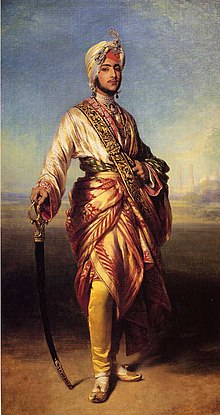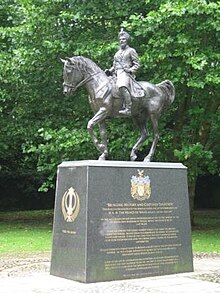Duleep Singh

Duleep Singh ( Panjabi ਦਲੀਪ ਸਿੰਘ Dalīp Siṃgh ; born September 6, 1838 in Lahore , † October 22, 1893 in Paris ) was the last Maharajah of the Sikh Empire .
Life
Duleep Singh ascended the throne of the Sikh Empire on September 18, 1843. Due to his young age, his mother Jind Kaur took over the government.
After the Indian army had lost in the course of the First Sikh War against the British at the Battle of Sobraon , Duleep traveled to Kasur to begin peace negotiations with the British Governor General Henry Hardinge . After the renewed defeat in the Second Sikh War , Duleep was forced to abdicate and had to relinquish his claim to the throne. In addition, he had to remain loyal to the British government, was only allowed to live in places that the governor-general determined for him and had to give the gemstone Koh-i-Noor as a gift to Queen Victoria . As compensation, the British East India Company promised Duleep, his relatives and servants a pension of 5,000 rupees a year.

At the age of 11, Duleep was exiled to Fatehgarh , where he came under the care of the Scottish doctor John Login and his wife. In March 1853, Duleep officially converted to the Christian faith. In April 1854 the board of directors of the East India Company allowed Duleep to visit England. On July 1 of the same year, he met Queen Victoria for the first time. She commissioned Franz Xaver Winterhalter to paint a portrait of Duleep and from then on he took part in life at the British court. Among other things, he met with the royal family at Osborne House and acquired the Elveden Hall country estate in Suffolk , where he went on hunting trips with prominent guests such as Prince Edward VII and Lord Balfour . In 1857, by a decision of the Board of Directors of the East India Company, Duleeps Pension was increased to £ 25,000 . On June 25, 1861, Duleep was named Knight Companion of the Order of the Star of India . In March 1873 Duleep became a member of the Carlton Club .
Due to his extravagant lifestyle, Duleep accumulated debt. He tried in vain to reclaim some of his former lands in Punjab , which the British displeased. In 1882 he wrote a letter to the Times describing the injustice he had seen and accused the British government of greed. Eventually Duleep converted to Sikhism and tried to return to India in 1886, but was arrested in Aden and henceforth lived in Paris. There he died of a seizure on October 22, 1893 . Within 24 hours, the British Foreign Secretary was tasked with bringing Duleep's body back to England and he was buried near Elveden Hall .
legacy
On July 29, 1999, Prince Charles inaugurated a bronze statue of Duleep in Thetford .
Individual evidence
- ↑ a b c Lena Campbell Login: Sir John Login and Duleep Singh . Nabu Press, 2010, ISBN 1-148-10296-5 , pp. 105, 108, 126-127 .
- ^ A b c d Michael Nelson, Asa Briggs: Queen Victoria and the Discovery of the Riviera . Tauris Parke Paperbacks, 2007, ISBN 1-84511-345-4 , pp. 63-66 .
- ↑ Gurharpal Singh, Darsham Singh Tatla: Sikhs in Britain: The Making of a Community . Zed Books, 2006, ISBN 1-84277-717-3 , pp. 44 .
- ^ Ajit Randhawa: Evolution of Faith and Religion: An Exploration . AuthorHouse, 2009, ISBN 1-4490-0081-9 , pp. 211 .
- ↑ a b c d Rozina Visram: Ayahs, Lascars and Princes: The Story of Indians in Britain 1700-1947 . Routledge, 2015, ISBN 1-317-41534-5 , pp. 72, 73 .
- ^ William Arthur Shaw: The knights of England: a complete record from the earliest time to the present day of the knights of all the orders of chivalry in England, Scotland, and Ireland, and of knights bachelors . Genealogical Publishing Com, 2002, ISBN 0-8063-0443-X , pp. 306 .
- ↑ Perminder Khatkar: Should the last Sikh maharajah be returned to India? In: BBC. July 4, 2014, accessed October 8, 2015 .
| personal data | |
|---|---|
| SURNAME | Singh, Duleep |
| ALTERNATIVE NAMES | Singh, Dalip |
| BRIEF DESCRIPTION | Maharajah of the Sikh Empire |
| DATE OF BIRTH | September 6, 1838 |
| PLACE OF BIRTH | Lahore |
| DATE OF DEATH | October 22, 1893 |
| Place of death | Paris |